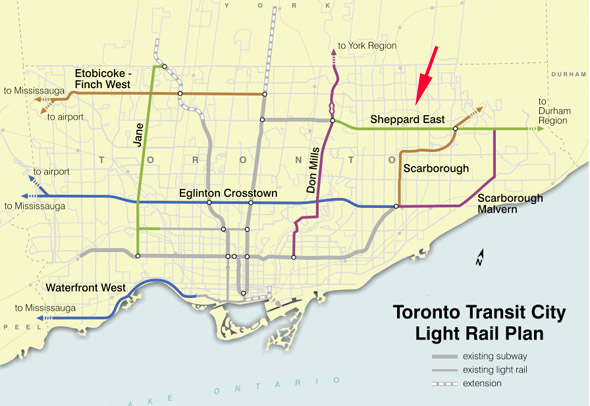Solid Snake
Active Member
http://www.toronto.ca/involved/projects/sheppard_east_lrt/pdf/completion/ea_report_master_part1.pdf
Page 9
The Sheppard East line brings nothing in a regional perspective. Metrolinx made clear that they wanted future investments to have a regional impact. The Sheppard line study neglected to calculate that a subway would also cut the travel time forYork region and Durham region passengers in a very significant way.
If you approched the Sheppard corridor in a regional perspective, subway is the way to go. Unfortunately, I seriously doubt that YRT, Durham and Go would reroute some of their route to Sheppard Lrt Stops. The LRT would do nothing to improve traffic on Yonge Street where most of the GO and YRT buses uses to reach Finch Station and this would not change with an LRT.
I also noticed that when they were estimating the project ridership for the Sheppard Subway line, not a word on the impacts of the YRT, GO rerouting their lines, not a word on potential drivers from the suburbs leaving their cars at Sheppard subway stations. Their projections are based on the areas close to Sheppard Avenue only which is a mistake. A subway would attract people from much far away.
Why haven't they studied Downsview to STC for a subway line? Studiying Don Mills to Meadowvale for a subway line is just forcing the numbers to justify the LRT over the subway.
Back on topic to fix Transit City...
-Eglinton's underground should be from Jane to Don Mills for phase 1 with LRT technology
-Than the city should budget to open a station per year along eglinton (Richview Corridor would drastically reduce the cost in the western part.
-Sheppard should be a subway from STC to Downsview
-Finch should still be built after the subway plan is taking cared of...Put Express branches in the meanwhile
-An Eglinton Subway might cut the need to have an LRT on Jane all the way to Bloor. It could stop at Eglinton or meet a future St.Clair Streetcar...Eglinton and Jane could be a final stop for a western DRL line
-Don Mills could have LRT from Steeles to Eglinton (Eglinton and Don Mills would be a good final station for a East DRL line)
-Instead of Sheppard LRT, they could explore the possibility of having Islington LRT, Lawrence LRT, Wilson/York Mills/ Ellesmere LRT
Thanks for reading my first post
Page 9
The Sheppard East line brings nothing in a regional perspective. Metrolinx made clear that they wanted future investments to have a regional impact. The Sheppard line study neglected to calculate that a subway would also cut the travel time forYork region and Durham region passengers in a very significant way.
If you approched the Sheppard corridor in a regional perspective, subway is the way to go. Unfortunately, I seriously doubt that YRT, Durham and Go would reroute some of their route to Sheppard Lrt Stops. The LRT would do nothing to improve traffic on Yonge Street where most of the GO and YRT buses uses to reach Finch Station and this would not change with an LRT.
I also noticed that when they were estimating the project ridership for the Sheppard Subway line, not a word on the impacts of the YRT, GO rerouting their lines, not a word on potential drivers from the suburbs leaving their cars at Sheppard subway stations. Their projections are based on the areas close to Sheppard Avenue only which is a mistake. A subway would attract people from much far away.
Why haven't they studied Downsview to STC for a subway line? Studiying Don Mills to Meadowvale for a subway line is just forcing the numbers to justify the LRT over the subway.
Back on topic to fix Transit City...
-Eglinton's underground should be from Jane to Don Mills for phase 1 with LRT technology
-Than the city should budget to open a station per year along eglinton (Richview Corridor would drastically reduce the cost in the western part.
-Sheppard should be a subway from STC to Downsview
-Finch should still be built after the subway plan is taking cared of...Put Express branches in the meanwhile
-An Eglinton Subway might cut the need to have an LRT on Jane all the way to Bloor. It could stop at Eglinton or meet a future St.Clair Streetcar...Eglinton and Jane could be a final stop for a western DRL line
-Don Mills could have LRT from Steeles to Eglinton (Eglinton and Don Mills would be a good final station for a East DRL line)
-Instead of Sheppard LRT, they could explore the possibility of having Islington LRT, Lawrence LRT, Wilson/York Mills/ Ellesmere LRT
Thanks for reading my first post
Last edited:







